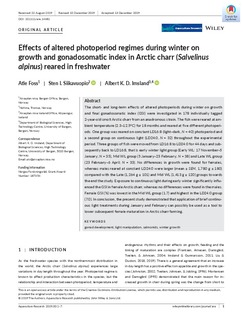| dc.description.abstract | The short- and long-term effects of altered photoperiods during winter on growth and final gonadosomatic index (GSI) were investigated in 178 individually tagged 2-year-old smolt Arctic charr from an anadromous strain. The fish were reared at ambient temperature (2.3–12.5°C) for 18 months and reared at five different photoperiods. One group was reared on constant LD16:8 (light–dark, N = 40) photoperiod and a second group on continuous light (LD24:0, N = 32) throughout the experimental period. Three groups of fish were moved from LD16:8 to LD24:0 for 44 days and subsequently back to LD16:8, that is early winter light group (Early WL: 17 November–5 January; N = 35), Mid WL group (5 January–23 February; N = 38) and Late WL group (23 February–6 April; N = 33). No differences in growth were found for females, whereas males reared at constant LD24:0 were larger (mean ± SEM, 1,780 g ± 180) compared with the Late (1,264 g ± 101) and Mid WL (1,413 g ± 120) groups towards the end the study. Exposure to continuous light during early winter significantly influenced the GSI in female Arctic charr, whereas no differences were found in the males. Female GSI (%) was lowest in the Mid WL group (1.7) and highest in the LD24:0 group (7.0). In conclusion, the present study demonstrated that application of brief continuous light treatments during January and February can possibly be used as a tool to lower subsequent female maturation in Arctic charr farming. | |
